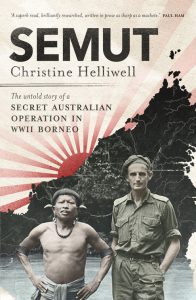If war is an innate to human societies, then an anthropologist is probably well placed to provide insights that are atypical to most military histories. Semut has been written by anthropologist Christine Helliwell and her account of this small chapter of the Second World War is refreshingly insightful and fascinating.

Operation Semut (derived from the Malay word for ant) was undertaken by Australia’s Services Reconnaissance Department in Sarawak in mid-1945 as part of the Allied campaign to recapture North Borneo. Operation Semut’s two main objectives were to gather intelligence and to encourage the indigenous people to launch a guerrilla war against the Japanese.
The operation was commanded by Major ‘Toby’ Carter and was divided into three main parties: Semut 1 under the command of Major Tom Harrisson, Semut 2 under the command of Carter himself, and Semut 3 under Captain ‘Bill’ Sochon. This book is the first of two planned volumes on Operation Semut and covers Semut 2 and Semut 3.
Sixty Allied soldiers participated in Semut 2 and 3. Some had some experience of the conditions and local culture in Borneo, but for many the culture and environmental ‘shock’ was significant. Most accounts of the Semut operations to date focus on the Europeans involved and paying scant attention to the local Dayak people that they cooperated with. Helliwell strives to correct this imbalance and has conducted hundreds of interviews to recreate a more holistic and detailed record of events.
As an anthropologist Helliwell has studied the Dayak peoples (comprising several tribal groups including the Kelabit, Kayan, Kenyah and Iban peoples) and has a very good understanding of their culture, lifestyle and attitudes as well as their natural environment. She also explores the dynamics between the European, Malay and Chinese expatriates in Borneo, as well as the occupying Japanese. Her account provides a more holistic and balanced perspective on the Semut operations – particularly the complex and nuanced relationships between the various groups.
As the narrative evolves Helliwell critically examines the numerous contradictions between previous accounts. She also delves deeply into the issue of headhunting – a local Dayak tradition that the colonial rulers had worked to eradicate, but which was conversely encouraged as part of the campaign.
Semut includes a number of images as well as over a dozen detailed and well-produced maps. Helliwell has undertaken extensive research to produce this account and the endnotes and bibliography run to 87 pages.
In modern vernacular, Operation Semut was a short but very successful example of advance force operations to understand and shape the battlespace ahead of conventional operations. The ‘classic’ special operations mission is to make contact, recruit and mobilise locals against a common enemy – typically well behind ‘enemy lines’. Semut provides an excellent account of this type of military operation and is highly recommended to students of unconventional warfare.
Contact Marcus Fielding about this article.






